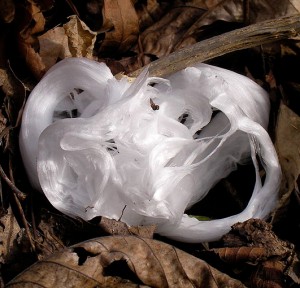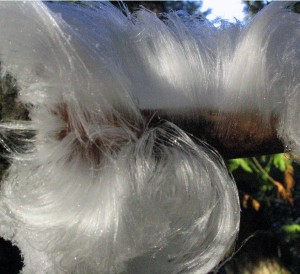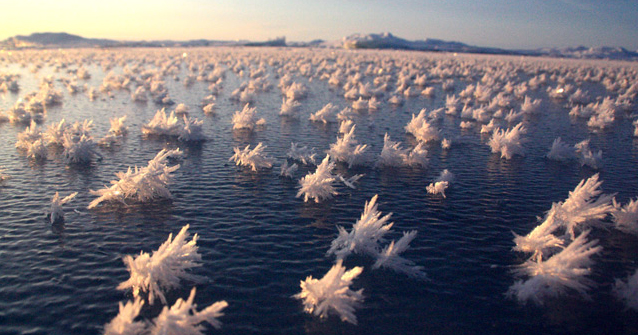Winter’s Mimics
Posted in Around the Garden, Science on January 17 2013, by Matt Newman
 Winter is … well, a weird time of year. We tromp around in oversized boots, brandishing umbrellas that hardly seem useful. The trees all stand–if a touch awkwardly–in stark and naked relief, while phases of matter bounce at whim between liquid and solid. As a gardener, it’s hard to be optimistic. Sure, there’s the arrival of seed catalogs to look forward to, and bulbs to be forced indoors, but repeated trips to the backyard to peek at the soil rarely prove fruitful … most of the time.
Winter is … well, a weird time of year. We tromp around in oversized boots, brandishing umbrellas that hardly seem useful. The trees all stand–if a touch awkwardly–in stark and naked relief, while phases of matter bounce at whim between liquid and solid. As a gardener, it’s hard to be optimistic. Sure, there’s the arrival of seed catalogs to look forward to, and bulbs to be forced indoors, but repeated trips to the backyard to peek at the soil rarely prove fruitful … most of the time.
Patience, an early rising, and a northerly location can prove that there’s beauty to be found in nature’s colder months, assuming you know where to look, because when the conditions are just right, at the edge of sunrise, frost flowers glitter.
I’m not referring to snowdrops, elegant as they are in late winter and early spring. “Frost flower” is more of a literal term. And when you see the leaves, vines, and gossamer threads formed through this unique interaction between plant and atmosphere, you’ll rightly understand how they came to earn this nickname.
Before we get carried away, know this: kicking off a bloom of frost flowers takes an uncommon soup of conditions. Most importantly, freezing weather has to fall on previously unfrozen ground. As the temperature drops, the sap held in the stems of nearby plants begins to freeze, causing it to expand. This expansion puts pressure on the stem itself, forming tiny splits and cracks along its length. That’s when capillary action takes the reins, drawing water from inside the plant and exposing it to the frigid air outside, where it ices over. As the water continues to seep outward, the ice that forms takes the shape of a fragile sheet, spiraling off in crystalline curls and waves. Think back to the shapes you’d make with the Play-Doh extruders of your childhood, and you’re on vaguely the right track.

Of course, curvy ice ribbons don’t even scratch the limit of winter’s imagination. Water pushed through the pores of heavier woods, such as tree branches, can spin off “ice beards,” silky furs of white frost that disintegrate when touched.
And if your garden is completely barren of vegetation, you might see small frost formations called needle ice, looking like a field of quartz pushing up through your soil. Sure, they’re not plants, and they’re incredibly fleeting, but they’re still something to marvel at, especially in a season of scant snow.
These beautiful frost formations (including several others you can check out here) aren’t just limited to dry land: out on the swells of the Arctic Ocean, perhaps the last place you’d expect to find these delicate blossoms, a University of Washington research team returning from the North Pole found just that–frost flowers springing to life right on the surface of the sea. Their advent, however, plays out a bit differently from the extrusion process that takes place in plants.
Instead, the scientists found a novel combination of factors in play; cracks between floes of pack ice expose sea water, which rapidly forms new ice under extreme sub-zero temperatures. The air above the water is saturated with moisture, so much so that even the smallest imperfections on the surface of the newly-formed ice provide footing for frost to seed. And seed it does. Building on its own crystalline structure, the small fleck blooms into a star-like frost flower, one stuffed to the brim with psychrophiles–microorganisms that thrive in frigid temperatures. With continuing research, these scientists now hope to use seaborne frost flowers to better understand life’s continued survival in extreme conditions, here and possibly elsewhere in the universe.

Unfortunately, we’re completely unable to replicate the Arctic Ocean in the Hardy Water Lily Pool, and the likelihood of conditions perfect for propagating terrestrial frost flowers in our gardens are pretty slim. Why? Somewhat ironically, you can blame New York City’s coastal location; all that water keeps our temperatures quite well modulated, despite what may sometimes feel like loopy seasonal swings. In addition, last year the USDA introduced a new set of hardiness zones, and the Garden moved from Zone 6A/6B to Zone 7A/7B. This means that our average extreme minimum temperature went from 0° to -10°F up to 10° – 0°F. According to Kristin Schleiter, the Garden’s Director of Outdoor Gardens, our planting beds have a very short period of dormancy, and while she has seen the occasional frost “lump” at the base of overwintering stems, she has never seen anything quite so substantial as the beauties making the rounds of the Internet this winter.
But that doesn’t mean that you shouldn’t venture out to visit us in winter. There’s a certain beauty to the Garden’s winter landscape, which a quick glance at our Instagram feed should swiftly prove. Of course, if despite all our protestations you still want to set out in hunt of the ever elusive frost flower amid our beds and Forest, (who are we to prevent you?) the early bird certainly gets the worm in this case. You’ll want to pick up an Early Morning Grounds Pass at the NYBG and race the sun to your frosted quarry. Think of it as a slightly less futile wintertime snipe hunt.
Frost flower and ice beard images courtesy of Wikimedia Commons.
Arctic Ocean image courtesy of This Is Colossal.

